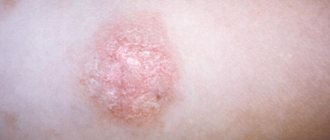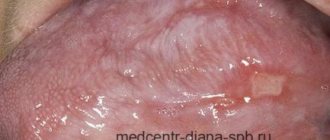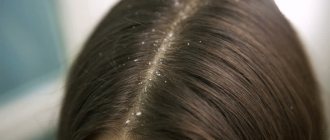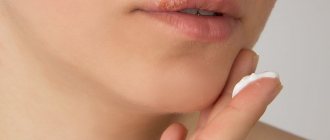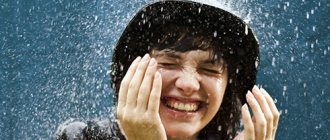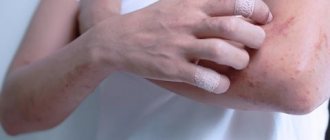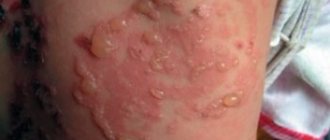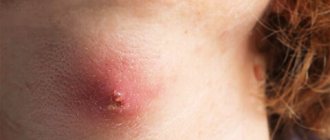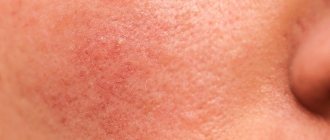Causes of tinea versicolor
The content of the article
Ringworm affects middle-aged people. Medicine identifies the causes that lead to the appearance of this disease in humans. These include:
- Predisposition to fungal skin diseases.
- Disruptions in the course of physiological processes in the epidermis.
- Endocrine diseases.
- Lack of a good night's sleep.
- Lack of rest.
- Time zone change.
- Excessive hygiene, using antiseptics.
- Improper functioning of the human immune system.
- Frequent bathing in salt water.
- Lack or excess of vitamins.
- Wearing clothes made of synthetic materials.
- Improper functioning of the lymphatic drainage system.
- Long-term use of steroid hormones.
- Nervous system problems.
- Hormone imbalance.
- Lack of hygiene measures in public places.
Multicolored leather
Pityriasis versicolor usually begins with the appearance of a small, not very inflamed pink spot that does not rise above the surface of the skin. Sometimes the color may be yellowish or coffee-colored. Gradually, the spot becomes overgrown with “brothers”; they merge into bizarre outlines, forming “geographical” patterns. Elements of multi-colored lichen are located on the skin of the chest, upper back, neck, and shoulders. Against the background of tanned skin, the spots look lighter. The spots tend to merge to form large foci, but can exist in isolation. There are no inflammatory phenomena, there is slight pityriasis-like peeling.
Method of infection
Mushrooms can come into contact with the skin of a healthy person, but with strong immunity, the body uses protective functions and the disease does not occur.
Main routes of transmission:
- Skin contact with the carrier.
- In public places: shower, fitting room.
- Use of a person’s personal belongings: towel, washcloth.
When infected with this microorganism, symptoms do not appear for 2 weeks to several months. They may not appear at all unless a situation arises when the immune system weakens.
Fungus loves heat and moisture
Pityriasis versicolor is a disease that is widespread everywhere, but it is more common in countries where the temperature and humidity are high. Young people are affected, and the disease is also registered in children. The risk of lichen versicolor increases in people suffering from excessive sweating, a certain chemical composition of sweat, favorable skin pH for the pathogen, with concomitant diseases: endocrine disorders, chronic diseases of the gastrointestinal tract, as well as immunodeficiency. In recent years, a genetic predisposition to the development of lichen versicolor has been clinically established. Often this disease develops against the background of pulmonary tuberculosis and lymphogranulomatosis, since these diseases are often accompanied by excessive sweating. Transmission of the pathogen from a patient with lichen versicolor or a carrier, for example, in a shared bed, or through shared clothing or underwear, is, in principle, possible. However, most people are carriers of the same fungi that are found on the skin (in areas rich in sebaceous glands) and do not cause disease.
Treatment of ringworm
A dermatologist makes the diagnosis and prescribes treatment. The specialist prescribes a number of studies of the affected areas:
- Balzer test.
- Histology analysis of tissue sample.
- Studying the condition of tissue under a microscope.
- Examination under Wood's lamp (fluorescent lamp).
Treatment includes the use of tablet medications, which contain ketoconazole, fluconazole and itraconazole, and ointments. They also use talkers that contain tar, salicylic ointment, salicylic alcohol (3%), and a solution of glycolic acid (5%).
Often, tinea versicolor does not cause serious complications, it only becomes inflamed due to friction. Causes an aesthetic problem. With conscientious treatment, the disease may recede. When conditions are right for the fungus, it may reappear.
ONLINE REGISTRATION at the DIANA clinic
You can sign up by calling the toll-free phone number 8-800-707-15-60 or filling out the contact form. In this case, we will contact you ourselves.
If you find an error, please select a piece of text and press Ctrl+Enter
A drop of iodine, a lamp beam, a microscope lens
In our Center, a wide variety of methods are used to diagnose lichen versicolor, one of which is the Balser iodine test: lesions and adjacent areas of healthy skin are smeared with 5% iodine tincture. Rashes due to the loosened stratum corneum are more intensely colored compared to the surrounding healthy skin. Just do not try to perform this test yourself, since only a doctor can diagnose the disease. When examined using a Wood's lamp, a yellow glow is noted in the affected area. Microscopically, in scales taken from foci of pityriasis versicolor and treated with a 15-20% KOH solution, budding fungal cells, as well as pseudomycelium, are detected. Another diagnostic method is the use of Sabouraud’s medium, on which after 3 weeks a white, creamy culture is formed, similar to yeast. Microscopic examination reveals budding fungal cells.
Symptoms of the disease
When infected with pityriasis versicolor, the pathogens multiply in the superficial layers of the skin, disrupting the normal functioning of cells. First of all, melanocytes, which are responsible for the production of the pigment melanin, are affected, thanks to which the skin has one color or another. This means that under the influence of pathogenic microorganisms, the affected areas acquire an uncharacteristic, painful shade. Hence the second name for pityriasis versicolor - versicolor.
The main symptoms of pityriasis versicolor include:
- Spots of yellow, coffee, scarlet or dark brown shades, located mainly on the back, head and neck, shoulders and stomach. In children, they also appear on the limbs, armpits and scalp. The affected areas can be of different sizes, but usually their size does not exceed 1 cm. Subsequently, the spots merge with each other, forming significant areas of the affected skin.
- No signs of inflammation in the form of redness, swelling, hyperemia and pain to the touch.
- Severe peeling of the skin in infected areas, aggravated by touch.
- No tanning on the affected areas.
Pityriasis versicolor is not characterized by itching and discomfort, so patients often mistake the manifestations of the disease for minor cosmetic defects, postponing a visit to the doctor and full treatment.
Such spots begin to itch and scratch only if a secondary infection occurs.
Reasons for development
Versicolor versicolor is a type of fungal skin infection that affects the stratum corneum of the epidermis and hair follicles. Its causative agents are two types of fungi, and infection is possible only through prolonged and close contact with the patient. And in this case, provoking factors play a big role. These include:
- weakened immunity;
- hyperhidrosis;
- disruption of the sebaceous glands;
- diseases of the endocrine system (obesity, diabetes, Itsenko-Cushing syndrome, etc.);
- hormonal imbalance due to pregnancy, menopause or taking hormone-containing medications;
- vegetative-vascular dystonia;
- abuse of antibacterial personal hygiene products;
- excessive exposure to ultraviolet rays (intense tanning, frequent visits to the solarium) and regular overheating of the body.
It is noteworthy that patients with pityriasis versicolor over 60 years of age are extremely rare. This is due to natural age-related changes in the skin, which make it less susceptible to pathogens.
In children under 10 years of age, the main causes of pityriasis versicolor infection are neglect of personal hygiene rules or improper skin care. At this age, with the protective functions of the skin intact, the body independently copes with pathogenic microorganisms attacking it, so the development of the disease does not occur. But closer to adolescence, when hormonal changes begin, the body’s susceptibility to bacteria, viruses and fungi increases, so children over 10 years old become infected with pityriasis versicolor just like adults.
Signs of the disease
Externally, erythrasma manifests itself in the form of light brown, brick-red, brown or yellow-brown spots on the skin, most often round in shape and without signs of inflammation. The diameter of the lesions can reach several centimeters, and they tend to merge, forming large affected areas. First of all, erythrasma spots appear in the folds of the skin, where there is a favorable environment for the proliferation of bacteria.
In addition to spots, erythrasma is characterized by:
- Peeling of the skin on the affected areas, aggravated by touch. Usually this is where the development of the disease begins.
- Mild, irregular itching. It intensifies and begins to cause significant discomfort only if a secondary infection is added to the primary disease.
- Absence of fever, wounds, ulcers and ulcers with copious discharge. This distinguishes erythrasma from most bacterial skin pathologies.
- Getting wet. An optional symptom, the manifestation of which depends on the amount of sweating and the quality of skin care.
It is noteworthy that in children, symptoms of erythrasma appear extremely rarely. The risk group includes adults, primarily men, who are predominantly overweight and prone to excessive sweating. In this case, in men, the skin in the groin, navel and inner thighs is usually affected, and in women, the entire abdomen, armpits and areas under the breasts are affected.
Is it possible to sunbathe with pityriasis versicolor?
This dermatosis is popularly called “sun fungus”: during the beach season, the yeast is activated and the disease is diagnosed most often. At the same time, the areas of the skin affected by the colonies do not tan and remain white - the patient is covered with light spots, which bring him to the dermatologist’s office.
Since pityriasis versicolor can be diagnosed during rest, patients are often interested in: is it possible to sunbathe with pityriasis versicolor? Opinions differ on this matter. Previously, quartz treatment was prescribed for the treatment of lichen versicolor: under the targeted influence of ultraviolet light, colonies of the fungus died. But now many dermatologists dispute this method of treatment.
UV radiation can be dangerous for an organism weakened by infection. In addition, the occurrence of pityriasis versicolor indicates a decrease in immune strength. Therefore, experts do not recommend exposing the skin to additional stress.
If the patient doubts whether it is possible to sunbathe with pityriasis versicolor, he is recommended to consult a dermatologist. The doctor will give recommendations taking into account the individual characteristics of the body, the severity of the disease, its form and location. If you follow medical prescriptions, the patient will avoid the complications of lichen and will be able to recover in a short time.
It should also be remembered that if the patient decides to sunbathe with pityriasis versicolor, the areas of the skin affected by the colonies will remain light: it will not be possible to get an even and beautiful tan. Therefore, it is better to first get rid of the disease, and only after that return to the beach.
Causes of pathology
Corynebacteria, which are the causative agents of the disease, are normally always present on human skin. Moreover, they provoke the development of pathology only under certain, favorable conditions. Corynebacteria do not penetrate deeper than the epidermis, and also do not affect nails and hair. Since the appearance of erythrasma is directly related to increased sweating, the disease most often manifests itself in the hot summer season.
Among the main reasons for the development of erythrasma are:
- hyperhidrosis;
- deviation of the normal pH of the skin to the alkaline side;
- diaper rash, constant friction and mechanical damage to the skin;
- dermatitis and other skin diseases;
- neglect of personal hygiene rules;
- wearing synthetic, overly warm clothing;
- the use of low-quality care products or the abuse of soap with an antibacterial effect, which destroys the natural protection of the skin.
Erythrasma is transmitted by contact, most often after the use of clothing, bedding and personal hygiene products of the patient. You can also become infected during sexual intercourse, when visiting a pool or bathhouse, and when walking barefoot on the ground or beach. At the same time, it is not always possible to accurately determine the source of infection, because the carrier may not have obvious external manifestations of the disease in the form of characteristic spots and peeling.
General provisions of therapeutic measures for tinea versicolor
The main condition for eliminating tinea versicolor is to contact a dermatologist, since self-prescription of drugs or the use of folk remedies is irrational. Incorrect selection of a course of medications during treatment or non-compliance with the dosage of medications can cause complications or relapse of the disease (repeated skin damage by the pathogen). The use of infusions, ointments, lotions and sprays, which are prepared according to folk recipes, is allowed to a person only after consultation with the attending physician and under his strict supervision.
Treatment of tinea versicolor is carried out strictly under the supervision of a specialist and consists of the use of medications, various ointments, special diets and physiotherapeutic procedures. Medicines are selected for each patient individually, depending on the cause of the fungal infection, the area of development of color pigmentation and the individual characteristics of the patient.
Depending on the degree of infection of the patient by the colored fungus, the method of therapeutic treatment is selected - outpatient (in the absence of a bacterial infection) or inpatient. Specialists use an integrated approach to treatment using local and systemic drugs. Ointments and creams cannot completely remove the causative agent of the disease, since they only have a superficial effect.
Treatment of tinea versicolor requires the dermatologist to prescribe medications and vitamin-mineral complexes to the patient that support the immune system and increase the body’s defenses. To enhance the healing effect of skin affected by lichen, physiotherapeutic techniques are used, which are carried out in the form of ultraviolet irradiation.
